Mammals of Kaziranga and Nameri
Many of the animals of Assam, whether in Kaziranga National Park or Nameri National Park are endangered ones; it gives one an extra lump in the throat when one sees them and feels that they may not be around too long. Well, efforts are on to make sure this doesn’t happen…so whenever you can, do support a good wildlife initiative!
Of the mammals, of course, the star of Kaziranga is the INDIAN ONE-HORNED RHINOCEROS . I don’t think it’s possible to NOT see a rhino in Kaziranga, but we were lucky to see one particularly aggressive rhino:
Our guide called this one “Mike Tyson” because of its appearance; a ear and the horn (nose) are missing…so, when I realized it was a female, I promptly dubbed her “Surpanakha”!
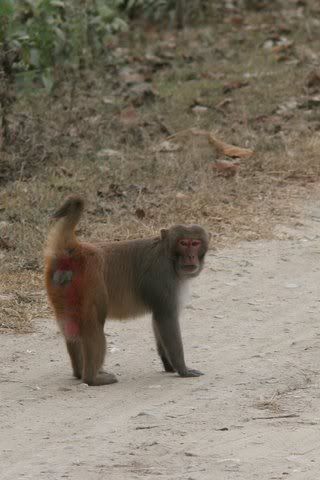 They are called "cap" macaques because of the whorl of hair on their heads, which looks as if they have a cap on:
They are called "cap" macaques because of the whorl of hair on their heads, which looks as if they have a cap on:
 Getting those looooong tails into the frame is a photographic challenge!
The other variety of macaques in Kaziranga are the ASSAMESE MACAQUES. There is no doubt that there look very different!
Getting those looooong tails into the frame is a photographic challenge!
The other variety of macaques in Kaziranga are the ASSAMESE MACAQUES. There is no doubt that there look very different!
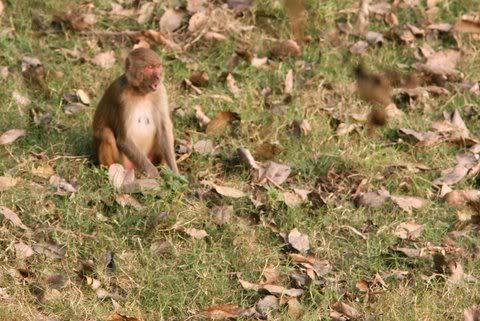 The faces have a very different appearance, but in the matter of behaviour, we found the groups of both macaques very similar....that's an apt word to use, as "simian" means, "of the apes".
information about macaques here .
The CAPPED LANGUR is another animal that lives in the trees of the Kaziranga forests. I got, as usual, a fairly lousy shot of this animal as it swung lithely through the trees:
The faces have a very different appearance, but in the matter of behaviour, we found the groups of both macaques very similar....that's an apt word to use, as "simian" means, "of the apes".
information about macaques here .
The CAPPED LANGUR is another animal that lives in the trees of the Kaziranga forests. I got, as usual, a fairly lousy shot of this animal as it swung lithely through the trees:
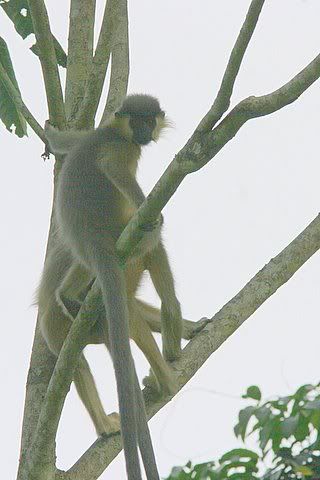
 This young doe certainly keeps up the meaning of the phrase, "doe-eyed"....one could get lost in the innocence of those eyes!
This young doe certainly keeps up the meaning of the phrase, "doe-eyed"....one could get lost in the innocence of those eyes!
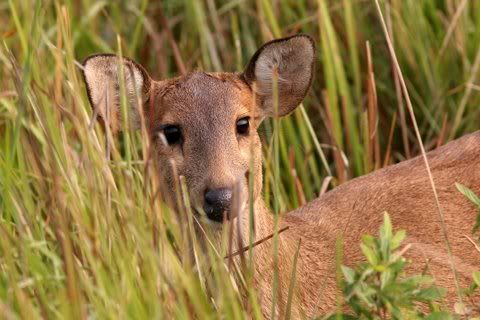 Having seen the BARASINGHA (SWAMP DEER) in Kanha National Park, Madhya Pradesh, last year, we enjoyed seeing them again in Kaziranga. The wiki on Barasingha says, "The Barasingha or Barasinga (Rucervus duvaucelii) is a species of deer, native to India and Nepal. In Assam in the North-East India, Barasingha is traditionally known as Dolhorina similar to its English name (Swamp Deer) as dol in Assamese means swamp.The race in Assam was subsequently assigned to a new race ranjitsinhi after M. K. Ranjitsinh. This race is considered the most threatened of the three." You can see the wiki entry here .
Having seen the BARASINGHA (SWAMP DEER) in Kanha National Park, Madhya Pradesh, last year, we enjoyed seeing them again in Kaziranga. The wiki on Barasingha says, "The Barasingha or Barasinga (Rucervus duvaucelii) is a species of deer, native to India and Nepal. In Assam in the North-East India, Barasingha is traditionally known as Dolhorina similar to its English name (Swamp Deer) as dol in Assamese means swamp.The race in Assam was subsequently assigned to a new race ranjitsinhi after M. K. Ranjitsinh. This race is considered the most threatened of the three." You can see the wiki entry here .
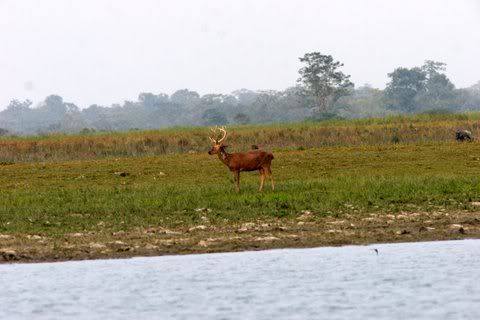 Here are some does and fawns, on the banks of the Bhomora river:
Here are some does and fawns, on the banks of the Bhomora river:
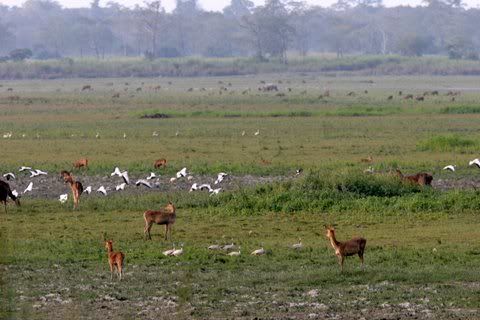 Of course I must not forget to mention that animal which is "burning bright/in the forests of the night"....
Of course I must not forget to mention that animal which is "burning bright/in the forests of the night"....
 this TIGER,too, looked quite different from others I have seen in north India. The coat was such a bright orange that instead of melting into the background, it actually stood out...and the head was quite large too. But I guess that's just because I haven't seen hundreds of tigers!
Here's the wiki entry on the tiger, and just in case you had forgotten, here's my tiger post .
One of the rare animals that one can see in the jungles of Kaziranga is the HOOLOCK GIBBON . It's the only ape found in India, and can be found only in the North-Eastern States. Our guide took us into the Panbari area of the National Park on a trek, and he hunted around for a while, before victoriously pointing upwards into the canopy of a tree, where a male and female were visible:
this TIGER,too, looked quite different from others I have seen in north India. The coat was such a bright orange that instead of melting into the background, it actually stood out...and the head was quite large too. But I guess that's just because I haven't seen hundreds of tigers!
Here's the wiki entry on the tiger, and just in case you had forgotten, here's my tiger post .
One of the rare animals that one can see in the jungles of Kaziranga is the HOOLOCK GIBBON . It's the only ape found in India, and can be found only in the North-Eastern States. Our guide took us into the Panbari area of the National Park on a trek, and he hunted around for a while, before victoriously pointing upwards into the canopy of a tree, where a male and female were visible:
 The male was far better visible than the female, who remained almost entirely hidden in the foliage. So we watched him for a while! I have a video of him, but haven't been able to upload it to YouTube yet...will add the link when I do so. Here he is, assuming the typical posture of careworn husbands the world over!
The male was far better visible than the female, who remained almost entirely hidden in the foliage. So we watched him for a while! I have a video of him, but haven't been able to upload it to YouTube yet...will add the link when I do so. Here he is, assuming the typical posture of careworn husbands the world over!
 ELEPHANTS were easy to sight in Kaziranga; a welcome change from south India, where they are getting to be a scarcer sight. We saw this handsome tusker having a dust bath on the banks of the Bhomora river (what do you call a tusker taking a dust bath? Dusker or Duster?)...he seemed to think that he was well-hidden by the plant in front of him, and didn't bother about us.
ELEPHANTS were easy to sight in Kaziranga; a welcome change from south India, where they are getting to be a scarcer sight. We saw this handsome tusker having a dust bath on the banks of the Bhomora river (what do you call a tusker taking a dust bath? Dusker or Duster?)...he seemed to think that he was well-hidden by the plant in front of him, and didn't bother about us.
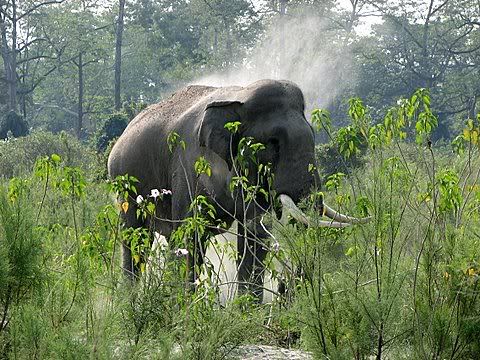 This solitary female was on the banks of the Jiyabharolli river, when we went rafting at Nameri:
This solitary female was on the banks of the Jiyabharolli river, when we went rafting at Nameri:
 I have not seen female elephants by themselves before; the "alpha female" usually has a couple of friends with her, if not a calf that she is taking care of.
We didn't see too many WILD BOAR, but the few specimens we did sight looked healthy and well-fed..obviously, they have been making pigs of themselves...
I have not seen female elephants by themselves before; the "alpha female" usually has a couple of friends with her, if not a calf that she is taking care of.
We didn't see too many WILD BOAR, but the few specimens we did sight looked healthy and well-fed..obviously, they have been making pigs of themselves...
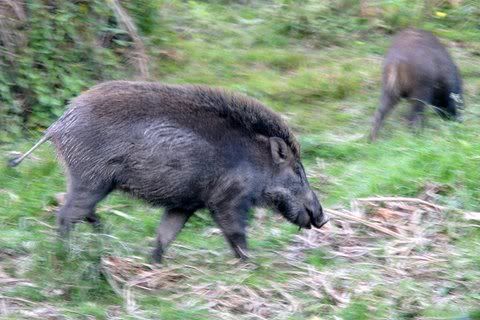 Along with the rhinos were lots of WILD BUFFALO; they too were handsome animals, and here's one having a nice green breakfast:
Along with the rhinos were lots of WILD BUFFALO; they too were handsome animals, and here's one having a nice green breakfast:
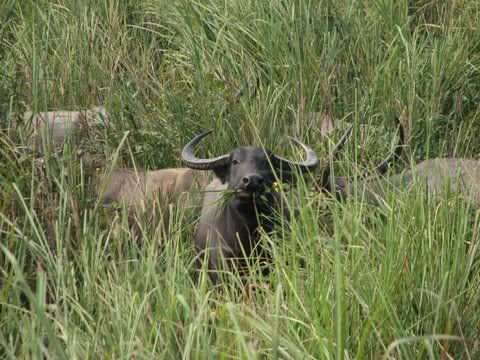 However, the rarest animals we saw were at right at the end of the wildlife part of the trip; we visited the Pygmy Hog Centre on the outskirts of Guwahati. Dr Gautam Narayan very kindly allowed us access, and we saw these creatures which cannot, possibly, be sighted in the wild any more.... a situation which the Centre hopes to correct.
However, the rarest animals we saw were at right at the end of the wildlife part of the trip; we visited the Pygmy Hog Centre on the outskirts of Guwahati. Dr Gautam Narayan very kindly allowed us access, and we saw these creatures which cannot, possibly, be sighted in the wild any more.... a situation which the Centre hopes to correct.

This may not seem like a very long list (especially after my bird list!) but it was a great experience to see animals that I am not likely to see again, for some time, at least!

